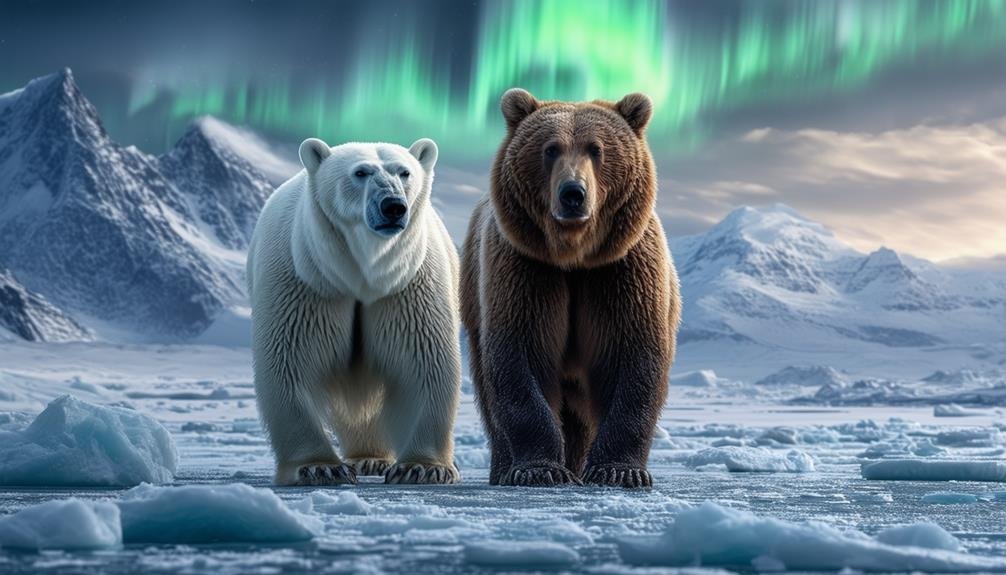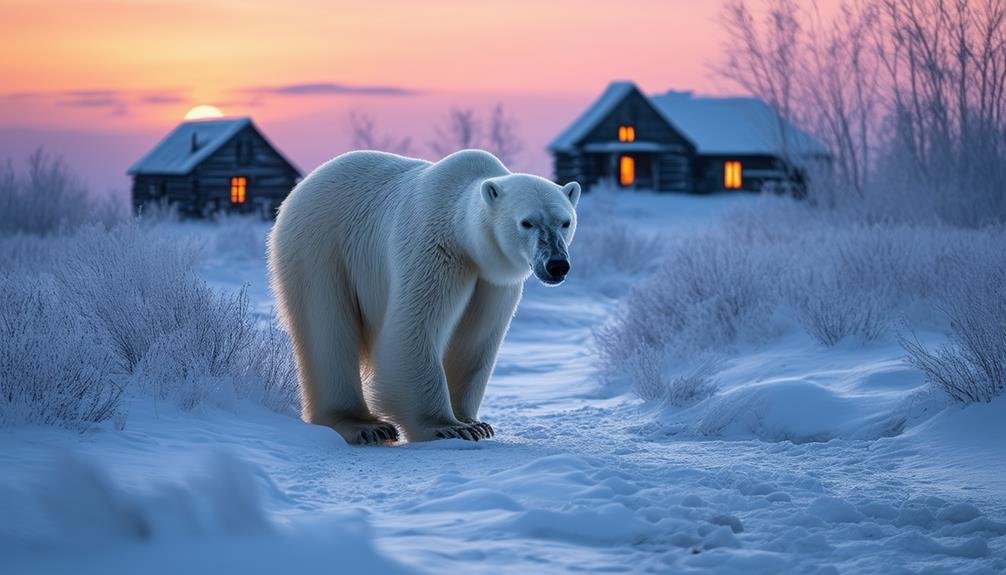Polar bears adapt to climate change through several strategies. They change their diet by incorporating vegetation and birds' eggs as traditional prey becomes scarce. Increased time on land leads them to explore new food sources and modify hunting behaviors. Interbreeding with grizzly bears generates hybrid offspring, potentially bringing new adaptive traits. Giving birth to smaller cubs enhances survival due to lower energy requirements. Finally, exploring human settlements due to melting sea ice creates new food-sourcing opportunities and necessitates conflict-mitigation strategies. Each adaptation reflects the polar bears' resilience in an evolving environment. Learn more about these fascinating survival mechanisms ahead.
Main Points
- Polar bears incorporate more vegetation and birds' eggs into their diet as traditional prey diminishes.
- They spend more time on land, adapting hunting and feeding behaviors to the melting sea ice.
- Interbreeding with grizzly bears creates hybrid offspring with potentially advantageous genetic traits.
- Polar bear mothers give birth to smaller cubs, which require fewer resources and are more resilient.
- Increased navigation of human settlements due to food scarcity leads to more human-bear interactions and conflict mitigation efforts.
Changing Diet
Polar bears are increasingly incorporating vegetation and birds' eggs into their diet as a response to the diminishing availability of traditional prey due to melting sea ice. This shift in diet is an essential adaptation strategy for polar bears to survive amidst climate change. As sea ice retreats, traditional hunting grounds for seals, their primary prey, become less accessible. Consequently, polar bears have been observed foraging for alternative food sources in their changing habitat.
In regions such as Greenland, where the impact of climate change is pronounced, bears are adapting by consuming more terrestrial resources. This changing diet includes various forms of vegetation and the eggs of ground-nesting birds. These newly integrated food sources provide vital nutrients that help sustain polar bears when traditional prey is scarce.
There is also evidence of genetic adaptations aiding this dietary shift. Some polar bears have begun interbreeding with grizzly bears, a process that may confer benefits in terms of dietary flexibility and resilience. The ability to diversify their diet is essential for polar bears' survival as the Arctic environment continues to transform. Adapting to new food sources underscores their resilience and ability to navigate the challenges posed by a warming climate.
Spending More Time on Land
As climate change continues to melt sea ice, polar bears are increasingly forced to spend more time on land, adapting their behaviors to survive in this altered environment. The rapid melting of sea ice, an essential platform for hunting seals, necessitates a shift in both hunting and feeding behaviors. Polar bears, traditionally dependent on sea ice for accessing their prey, now face significant challenges in procuring food.
Adaptation to terrestrial life involves exploring new food sources and altering traditional hunting tactics. This shift also brings polar bears into closer proximity to human settlements, leading to increased human interactions. Such interactions can pose risks to both polar bears and humans, highlighting the need for effective management strategies to mitigate conflicts.
The resilience of polar bears is evident as they navigate these changing environments. Their ability to adapt showcases their inherent survival skills, yet the challenges they face are considerable. As they spend more time on land, the potential for conflicts with human activities rises, emphasizing the importance of research and conservation efforts. Understanding these adaptive behaviors is vital in developing strategies to support polar bears in a world increasingly shaped by climate change.
Interbreeding With Grizzlies

Fascinatingly, some polar bears are interbreeding with grizzly bears, resulting in hybrid offspring known as 'pizzly bears' or 'grolar bears.' This phenomenon arises as polar bears are compelled to spend more time on land due to the melting sea ice, leading to increased encounters with grizzly bears. Hybridization, though rare, occurs in regions where the habitats of these two species overlap.
The genetic mixing between polar bears and grizzly bears may yield new adaptations, potentially equipping the hybrid offspring with traits that aid survival in the face of environmental challenges. As the habitats of these majestic creatures change, such interbreeding represents a dynamic response to the pressures exerted by climate change.
This genetic intermingling is a proof of the adaptability of species confronting shifting ecosystems. While polar bears traditionally thrive in Arctic environments, their interbreeding with grizzly bears—a species more accustomed to terrestrial habitats—illustrates how wildlife can adapt through genetic diversity. Ultimately, interbreeding between polar bears and grizzly bears highlights the complex and multifaceted ways in which species navigate and respond to the profound impacts of climate change, underscoring the intricate balance of adaptation and survival in a rapidly evolving world.
Smaller Cubs for Survival
In response to the pressures of climate change, polar bear mothers are increasingly giving birth to smaller cubs, enhancing their offspring's chances of survival in a rapidly changing environment. This significant adaptation is pivotal for polar bears as they navigate the harsh realities of their shifting habitat.
The trend towards smaller cubs offers several advantages:
- Reduced Competition for Resources: Smaller cubs require less food, making it easier for them to survive during periods of food scarcity.
- Improved Hunting Conditions: Smaller size means that these cubs can more efficiently hunt and capture prey in a landscape where resources are becoming increasingly scarce.
- Lower Energy Requirements: Smaller cubs demand less energy from their mothers, allowing the adult bears to better manage their own energy reserves.
- Resilience to Environmental Challenges: The smaller size of these cubs makes them more adaptable and resilient to the environmental challenges posed by climate change.
This adaptation not only underscores the resilience of polar bears but also highlights their ability to cope with the direct impacts of climate change on their habitat. As food scarcity and changing hunting conditions become more prevalent, the survival advantage provided by smaller cubs will be an essential strategy for polar bears in the face of ongoing environmental challenges.
Navigating Human Settlements

Polar bears are increasingly venturing into human settlements as melting sea ice diminishes their natural hunting grounds. This behavioral shift has led to a rise in encounters between humans and polar bears, often driven by the bears' search for food. As their traditional prey becomes harder to access, these apex predators have been observed scavenging in towns and villages near the Arctic, raising significant safety concerns.
The intersection of polar bears with human settlements underscores the broader impacts of climate change on wildlife. Conservationists are actively developing strategies to mitigate conflicts and guarantee the safety of both humans and polar bears. These strategies include community education programs, improved waste management systems to reduce food scavenging opportunities, and the creation of deterrents to keep bears away from populated areas.
Understanding the adaptability of polar bears to these changing habitats is essential for their long-term survival. By closely monitoring their movements and interactions within human settlements, researchers can better inform conservation efforts. The table below highlights key areas of focus in these efforts:
| Key Area | Description | Example Strategies |
|---|---|---|
| Food Scavenging | Bears searching for food in human areas | Secure waste bins, remove attractants |
| Conflicts | Encounters between bears and humans | Education programs, bear patrols |
| Conservation | Efforts to protect bears and communities | Habitat preservation, policy changes |
| Adaptability | Polar bears adjusting to new environments | Research on behavior, habitat use |
| Melting Sea Ice | Loss of natural hunting grounds | Climate action, habitat restoration |
How Do Polar Bears Adapt to Climate Change, and Are There New Strategies Emerging?
Polar bears are adapting to climate change by shifting their hunting patterns and traveling further in search of food. With sea ice melting, they rely more on land-based prey. Researchers continue to explore new strategies to understand how polar bears adapt, as changing Arctic conditions force them to develop survival tactics.
Conclusion
Polar bears have demonstrated remarkable adaptability to climate change through various strategies. These include altering their diet, increasing time spent on land, interbreeding with grizzlies, producing smaller cubs for better survival prospects, and maneuvering around human settlements. These adaptations highlight the species' resilience and the ongoing need for conservation efforts to support their survival in a changing environment. Understanding these behaviors is essential for developing effective measures to mitigate the impacts of climate change on polar bear populations.


